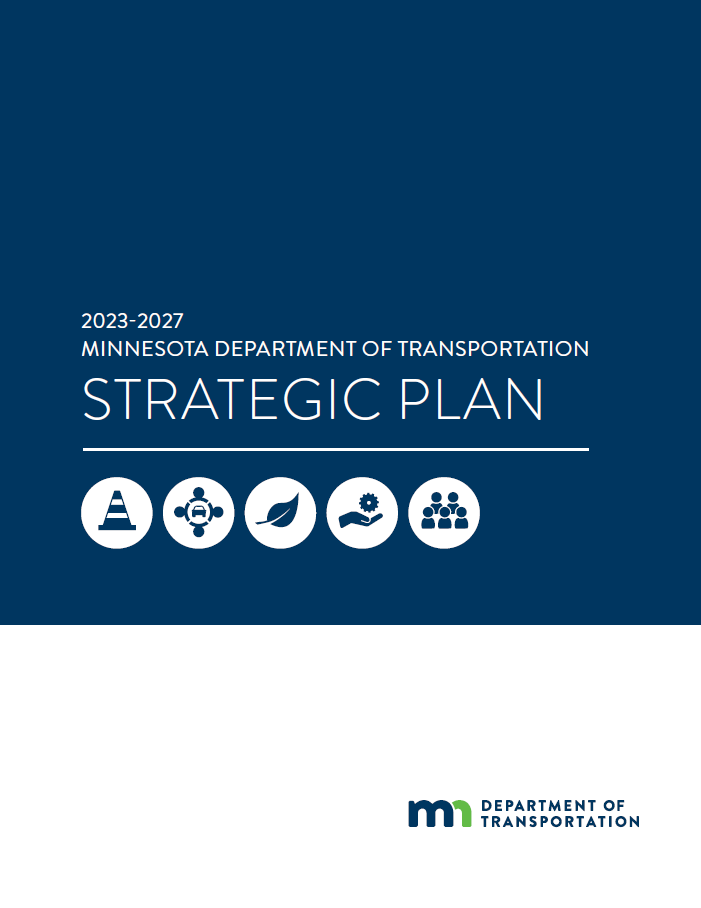Our strategic direction

Vision
Minnesota’s multimodal transportation system maximizes the health of people, the environment and our economy
Mission
Connect and serve all people through a safe, equitable and sustainable transportation system
Values
Our values guide how all MnDOT employees show up each day on behalf of Minnesotans
- Safety: We recognize safety is core to our work and build it into everything we do.
- Service: We take pride in our work and hold ourselves to the highest standards.
- Equity: We actively remove barriers to create an inclusive transportation system that benefits all.
- Sustainability: We act today to contribute to a better transportation system of the future.
- Innovation: We search for new ideas, experiment to learn and grow and create value for the public.
- Collaboration: We leverage the contributions of our team members and partners, acknowledging the impact we can have together.
Our day-to-day work
Transportation is about connecting people to family, friends and community. Everyone who lives in or passes through our state is impacted by our transportation system. Whether traveling to a school, retail or grocery store, sporting event, clinic, place of work or special event, our lives are touched nearly every day by our access to transportation.
A multimodal transportation system
While we are most visible for keeping roads clear in the winter and constructing and maintaining roads and bridges, MnDOT’s responsibilities are much broader than that.
We develop and implement transportation policies, create long-term plans and programs and regulate operations for airports, freight carriers, railroads, transit providers and waterways.
We play an important role in maintaining and improving bicycling and walking infrastructure and play a leading role in Minnesota’s Toward Zero Deaths goals.
Our strategic goals
Our goals demonstrate our commitment to creating a safe, equitable and sustainable transportation system. We will advance statewide goals and continue to build and maintain a comprehensive transportation system that serves Minnesotans now and into the future - including enhancing pedestrian safety, reducing transportation’s impact on greenhouse gas emissions and cultivating a more diverse transportation industry and workforce.
Strategic alignment
We recognize that MnDOT is not alone in tackling these critical transportation challenges. We have opportunities to engage with and learn from efforts happening nationally and within Minnesota. By creating alignment at every level, we’ve developed a plan that is specific to MnDOT, yet provides support for broader transportation policy and investment initiatives.
- The U.S. DOT Strategic Plan establishes the U.S. Department of Transportation’s strategic goals and objectives. This is a roadmap for transformative investments that will modernize our infrastructure to deliver safer, cleaner and more equitable transportation systems.
- The One Minnesota Strategic Plan identifies the State of Minnesota’s mission, vision, guiding principles and priorities.
- The Statewide Multimodal Transportation Plan is Minnesota’s highest level policy plan for transportation. The policy direction is established with partners, stakeholders, and the public. It is a 20-year plan based on Minnesota GO - a vision of a transportation system that maximizes the health of people, the environment and our economy. It supports the 16 goals for transportation established by the Minnesota Legislature. The plan is for all types of transportation and all transportation partners.
- MnDOT’s Agency Risk Register assesses agency risk by identifying, analyzing and evaluating uncertainty associated with capital, governance and organizational objectives.
Goals outline
Our 2023-2027 strategic goals are:
- Promote a safety culture
- Advance transportation equity
- Champion sustainability actions
- Maximize stewardship of resources
- Foster a thriving workforce
Each goal has key objectives, strategies and performance measures identified. Our strategies are intended to be examples of actions that MnDOT can take to advance our goals. Our performance measures are quantitative measures to show our progress toward the goals and related objectives. To track progress, some measures focus on whether a strategy is making a difference for people receiving services and members of the public broadly, while others focus on the quality of our efforts. We anticipate that new strategies and performance measures will emerge as we research, innovate and collaborate in each of these key objectives.
How we implement
Making progress on these strategic goals will require a collaborative and flexible approach. We will need engagement at all levels of MnDOT. Our managers, supervisors and employees all have a part in ensuring we are creating a safe, equitable and sustainable transportation system.
Implementation principles
- We will leverage existing plans, committees, measures and proven strategies wherever possible to expand our capacity and increase our impact.
- Where MnDOT has an established and long-standing track record, we will rethink our approach and try innovative solutions.
- Where objectives and strategies are emerging and less defined, we will explore, research and collaborate with our partners to find the best path forward. We may not always get it right the first time and we must be ready and willing to acknowledge mistakes and shift direction.
Tracking progress
Our state, our communities and our agency will continually be faced with new challenges and opportunities. MnDOT’s goal is a 2023-2027 Strategic Plan that remains timely, relevant and adaptable to our employees and stakeholders. MnDOT’s Commissioner and Senior Leadership Team will champion the plan and our strategic goals will be regularly communicated agency wide, and employees will have access to information on progress.
Each year, we will do a full assessment of our overall plan and the performance measure trends to identify where we may need to adjust our strategies. Two strategic goals MnDOT has currently prioritized for further performance measure development are Advance Transportation Equity and Foster a Thriving Workforce. MnDOT is in the process of collaborating with our staff, partners and community members to identify performance measures that best inform the strategies.
